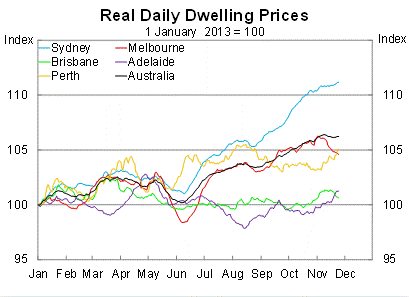A Sydney-centric housing boom
Has the recent dwelling price ‘boom’ extended beyond Sydney? Not really.
Based on daily data from RP Data, dwelling price growth slowed in November and is 0.3 per cent above its level in October (as of 24 November). Prices in Melbourne are down by 1.3 per cent in November to date, while prices in Sydney are up 0.9 per cent – much slower than in recent months but still 11 per cent higher on an annualised basis.
Prices have picked up a bit in Adelaide and Perth, with growth of 1.7 per cent and 2.0 per cent respectively in November to date. Prices are up only slightly in Brisbane.
One of my pet peeves with house price analysis is the focus on nominal prices rather than real prices. The distinction can sometimes distort the coverage. As a result, I derived a daily real dwelling price index. The results are contained in the graph below.
Based on the data, the house price boom is a Sydney-centric phenomenon, although Sydney can sometimes be a leading indicator for prices in other capital cities. While real prices in Sydney are up by 11 per cent in 2013 to date, price growth in the next four biggest cities is much lower.
Real prices in Melbourne are up 4.5 per cent and in Perth by 4.9 per cent since the beginning of the year. For Perth, that level of growth is likely to be around income growth, so no boom there. But as the graph shows, prices in Perth have done nothing since June and growth has slowed in Melbourne since July.

Real dwelling prices in both Brisbane and Adelaide are doing very little, rising by 0.6 per cent and 1.1 per cent in 2013 to date respectively. It must be noted that it is unwise to put too much weight on short-term variations in the daily dwelling price index, particularly given the data is not revised or seasonally adjusted. Nevertheless, the analysis would not differ at all if I had used the quarterly ABS measure of house prices.
Given the historically low mortgage rates, I am actually surprised by the lack of house price growth. With the exception of Sydney, none of the markets are performing particularly strongly in 2013. The question is: why?
First home buyers? No. First home buyer activity is at a historically low level in a number of states, including New South Wales. Although this factor obviously hasn’t harmed Sydney prices so far, first home buyer activity is typically a fairly important driver of price growth. This factor is one of the main reasons that I’m fairly bearish about the housing market in 2014.
Income growth? No. Income growth is relatively subdued across the country and labour market conditions are soft. New South Wales has one of the weakest labour markets in the country. This level of income and employment growth is not typically connected with strong house price growth.
Investors? Possibly. Investor activity has picked up noticeably during 2013, particularly in New South Wales. The value of investor loan approvals in New South Wales has increased by around 30 per cent annually over the year to September. Investor activity has also picked up in Western Australia by 22 per cent. Investor activity in Queensland and South Australia is growing more moderately (both up by around 6.5 per cent), while in Victoria the value of investor loan approvals are up by around 15 per cent.
So what does this say about the market? Low interest rates boosted demand to some extent, although mostly for investors. Investor activity is boosting prices in New South Wales and supporting growth in Western Australia and Victoria, although not to the extent that prices have picked up significantly. The two states where investor demand is weakest have experienced only modest dwelling price growth in 2013.
It looks as though the market would fall away if investor activity slowed. Domestic conditions simply don’t warrant a great deal of price growth right now, even with low mortgage rates. Investor activity can only sustain a market for so long; for Sydney, that points to price growth slowing considerably in 2014. Prices could pick up a bit in the other states, but I expect subdued labour market conditions and income growth to ensure this house price boom remains a Sydney-centric phenomenon.















